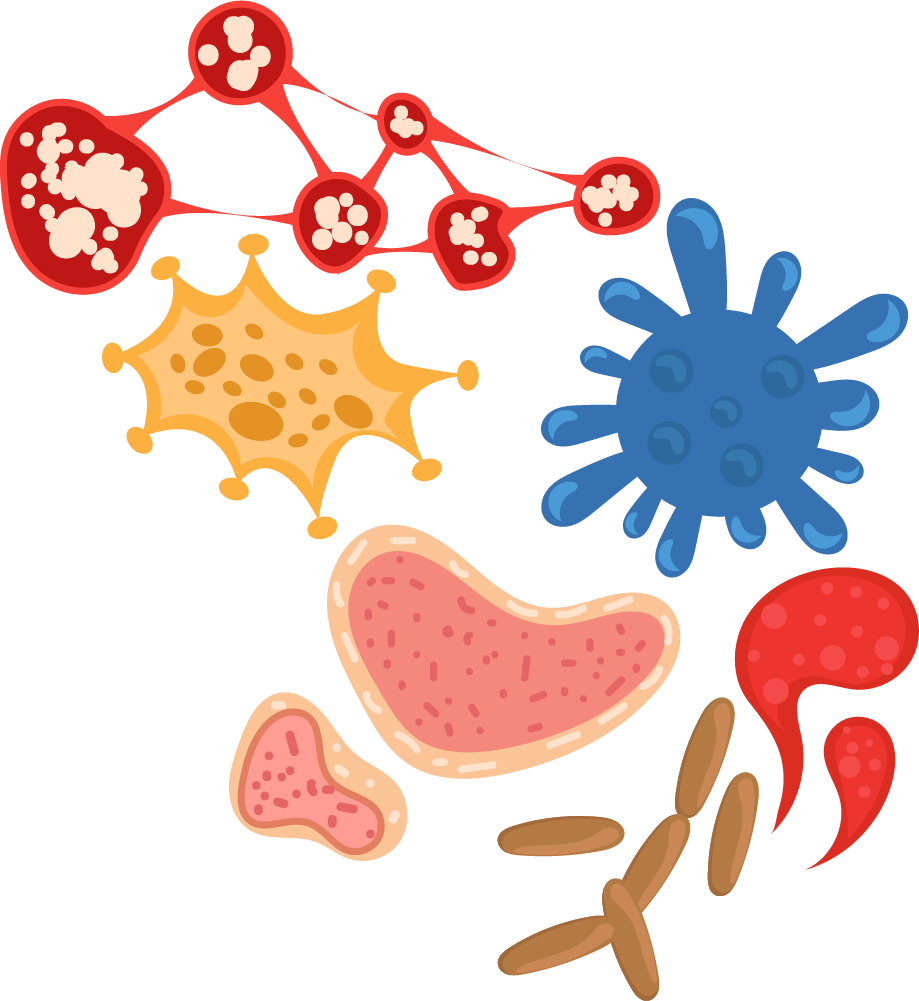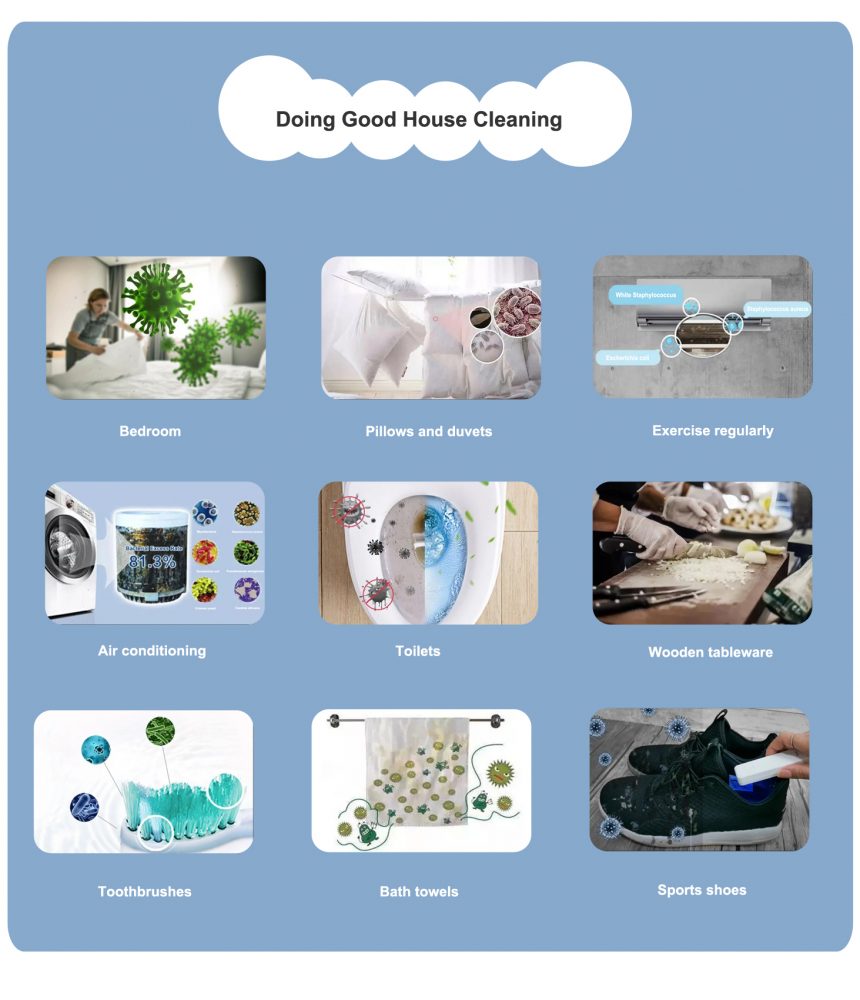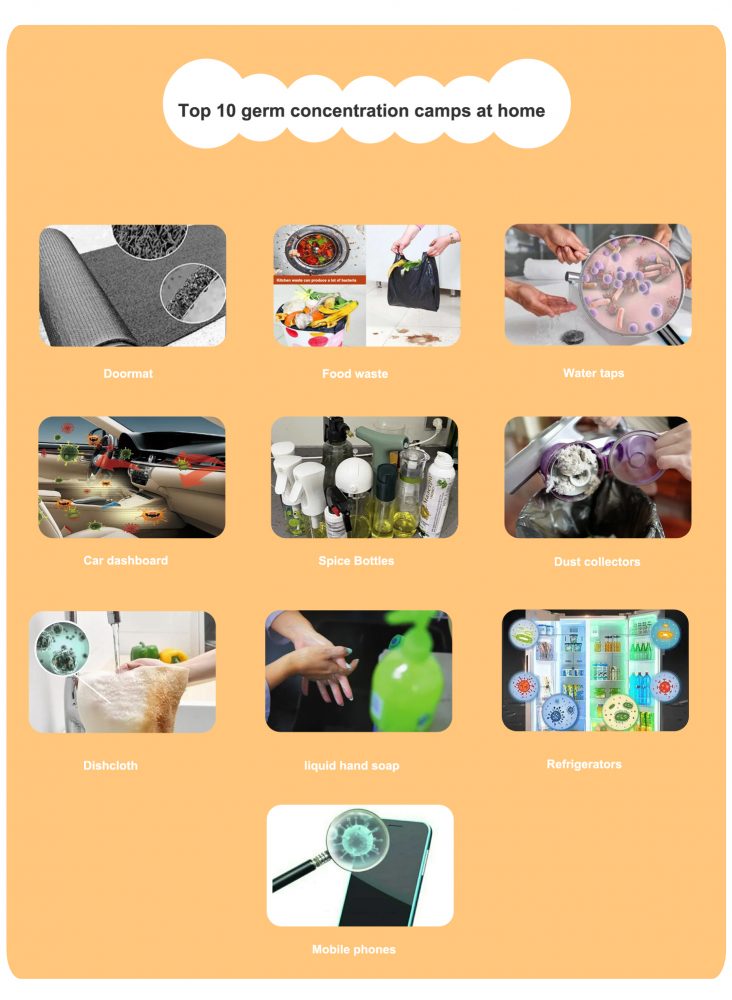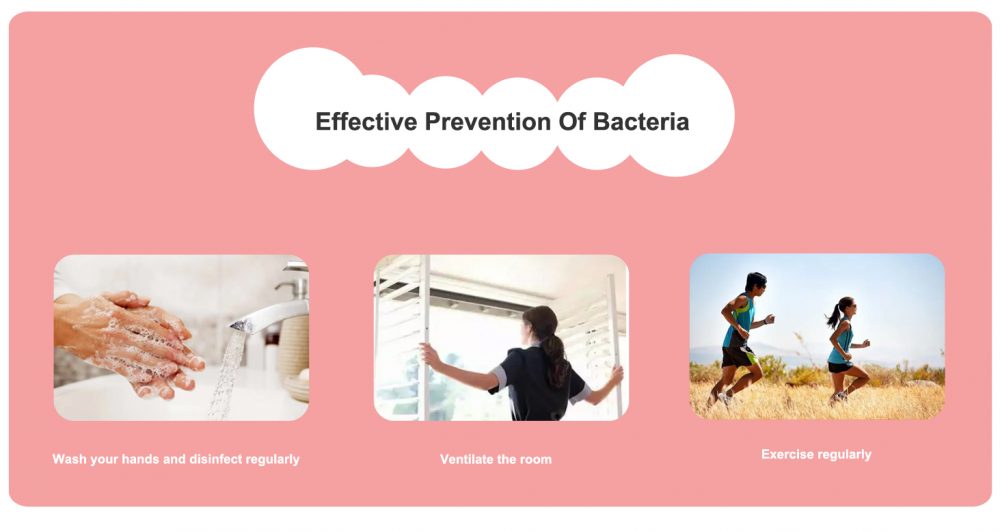There is a kind of microorganism that you cannot see or touch, but is closely related to our lives: bacteria, which are harmful to the human body mainly because they can cause infections and may lead to fever and other symptoms,because everyone has a different body type, germs usually attack people who are weaker. Many diseases are caused by bacteria and viruses, so do we know what the dangers of bacteria are?
In everyone’s consciousness, home is always synonymous with warmth and cleanliness, but did you know that? The number of bacteria and fungi hidden in the home may be much greater than we think. One study showed that the average household dust harbours an average of 9,000 different microorganisms. The average household dust harbours more than 2,000 different fungi and more than 7,000 bacteria. Not only are there common fungi such as Aspergillus, Penicillium spp., Streptomyces and Fusarium, but also bacteria like Staphylococcus and Streptococcus, which are associated with human skin, as well as Bacteroides and Clostridium from faeces, to name but a few.

Only by creating a good hygienic environment can we keep germs away and live a healthy life, are you doing a good job of cleaning your home?

Bedroom: With the average person spending 7-8 hours a day in bed, a bed is very important to our health. Pillows and mattresses are often breeding grounds for bacteria, and on average there are 10 million dust mites in each bed. Dust mites can cause itchy skin and may even lead to allergies.
Pillows and duvets:The weight of a new pillow will double within 3 years due to the build-up of dust mite debris, which can aggravate symptoms of illnesses such as asthma and eczema, and dust mite excretions can also cause rhinitis and sinusitis. This is why pillows should be washed in water at 60 degrees Celsius for at least 20 minutes every two or three months. Duvets can also accumulate dust mites and skin debris and should be washed every six months. It is also advisable to keep pillows in the sun for 2 years and duvets for 5 years.
Air conditioners: According to the findings of the Chinese CDC, 80% of air conditioner fins exceeded the bacterial count, and by as much as 1000 times or more. Air conditioners that are used for a long time and not cleaned in time can easily accumulate dust, bacteria mould and even infectious germs, becoming a gathering place for bacteria such as white staphylococcus, staphylococcus aureus and E. coli, etc., which we spread out during use and can be hazardous to health. Long-term use of air conditioners with bacteria build-up can easily cause allergic reactions, infections such as rhinitis, laryngitis and other respiratory diseases, and can even bring on influenza or even hand, foot and mouth disease.
Washing machines: their interiors can easily become a breeding ground for bacteria. According to the data, the detection rate of mould in the inner tank of washing machines was 60.2%, the total bacteria detection rate was 81.3% and the total coliform detection rate was as high as 100%, with 54.7% of washing machines containing all three types of bacteria at the same time. The gap between the inside and outside of the two drums of automatic washing machines is more likely to accumulate dust and bacteria, causing secondary pollution to clothes, causing skin diseases such as sweat spots and ringworm, as well as viral hepatitis, typhoid, dysentery and other diseases that can cause infection through clothes and infect families.
Toilets: Studies have shown that over 60% of toilet seats are contaminated with excrement. One study states that the inside of a freshly flushed toilet still has up to 100,000 bacteria on it. If flushed with the lid open, the instant cyclone inside the toilet can carry germs and microorganisms up to six metres into the air and suspend them for up to several hours, where these invisible droplets can carry germs and land on surrounding walls and objects. Other parts of the toilet, such as the shower curtain, flush button, taps and door handles may already be covered in germs. When finished using the toilet, it is best to use toilet wipes to care for your private parts.
Wooden cutlery: wood is more likely to leach moisture than plastic or metal and therefore has a greater chance of carrying bacteria. When cleaning wooden cutlery, it is best to use hot water and, after a while, to boil it in water. If the wood becomes soft and black, it means that the inside has become mouldy and should be replaced immediately.
Toothbrush:A study by the University of Manchester in the UK found that the average toothbrush carries 10 million bacteria, with a high percentage of staphylococcus, streptococcus and E. coli. It is recommended to change them every 3 months.
Bath towels:Staphylococcus aureus bacteria on the skin can remain on the towel and can easily cause infection if it then comes into contact with the wound. Bath towels should be ironed at least once a week in hot water above 90 degrees Celsius.
Sports shoes: these shoes are susceptible to mould and fungal contamination, so wash them at least once a month in cool, soapy water and dry them in the sun. When the surface of sports shoes is stained, it is best to use wipes to clean the stains first to avoid the build-up of bacteria.
Top 10 germ concentration camps in the home:

1.Doormats collect bacteria from the soles of shoes
A study found that nearly 96% of shoe soles had E. coli bacteria. Experts say that the area near the door is one of the dirtiest areas of the home and if germs collect on the doormat, they will be brought into the house every time you pass it and enter the home.
How to get rid of germs: disinfect the doormat weekly with a germ remover; keep shoes outside the door as much as possible; do not put bags or groceries on the doormat.
2.Overnight waste harbours a lot of bacteria
The kitchen sink has more than 500,000 germs, which is 1,000 times more than the average bathroom germ count. This is because sinks are damp and often accumulate waste, and if they are not cleaned promptly, germs can grow in the hidden crevices. This means that dishes, kitchen utensils and even hands can be contaminated by them. Likewise, food waste that is not emptied in time can harbour a lot of bacteria.
How to get rid of germs:: clean the sink at least weekly with diluted bleach; take out the food waste the same day.
3.Taps are vulnerable to food contamination
Running water makes the tap wet, making it an ideal place for germs to multiply. If you accidentally touch the tap with dirty hands or if the tap is contaminated with food, germs will multiply in the tap and eventually form a microbial film that adheres to it, which can grow large and break, falling onto food and dishes and endangering personal health.
How to get rid of germs:: soak weekly in diluted bleach and then let the tap water run for a while before using.
4.Car dashboards are a breeding ground for mould spores
Warm dashboards are conducive to the growth of germs, and when air containing mould spores and bacteria is sucked into the car, it usually adheres to it.
How to get rid of germs:: Wipe down the interior of your car frequently with a disinfectant solution or disinfectant wipes, especially during allergy season.
5.Spice bottles may be able to cause cross-contamination
Many people do not wash their hands before accessing bottles of vinegar, soy sauce, ketchup and other condiments, which may result in cross-contamination of germs.
How to remove bacteria: often wipe the outside surface of the spice bottle with kitchen wipes to disinfect it; try not to let the spices flow onto the bottle when using it and clean it in time.
6.Hoovers suck in large amounts of E. coli
One study found that 13% of hoovers had E. coli bacteria, meaning that every time they are used, they can spread the germs around.
How to get rid of germs:: replace the dust bag outdoors; preferably use a hoover with an anti-bacteria dust bag; for hoovers without a dust bag, wash regularly with bleach and dry naturally.
7.Dishcloths spread bacteria easily
Studies have found that 7% of dishcloths are contaminated with Staphylococcus aureus, a superbug that can cause deadly skin infections. Dishcloths are also thought to be the item that collects the most E. coli and other bacteria in the home. People often use dishcloths to wipe up food spills and then reuse them without washing them, which can spread germs.
How to get rid of germs:: use kitchen paper towels to dry dishes; use disposable dishcloths where possible.
8.Handwash bottles contaminated with faecal bacteria
About 25% of hand soap bottles are contaminated with faecal bacteria. Experts say that as soap scum accumulates, bacteria grows with it.
How to get rid of bacteria: It is best to scrub under running water for 15-20 seconds each time you wash your hands and carry wet wipes in your bag so you can use it outdoors.
9.Refrigerator seals are prone to spreading mould
An investigation by the University of Arizona in the USA found that the seals of refrigerators have an 83% chance of detecting mould. Every time the fridge door is opened, these moulds take advantage of the opportunity to spread.
How to get rid of germs:: clean the fridge seal at least weekly using diluted bleach or disinfectant.
10.Mobile phones are the ideal place for germs to grow
Mobile phones carry a large number of germs, including staphylococcus, which can cause skin infections, pseudomonas, which can cause eye infections, and salmonella. The gaps in mobile phone cases can also provide an ideal place for germs to grow.
How to get rid of germs: Don’t leave your phone lying around; wipe it down with a disinfectant wipe every day.
How to prevent bacterial infections more effectively:
Life is full of germs. For example, in the year 2020, the term “New Coronavirus” is still active every day. The virus can be transmitted by human and animal faeces, urine, sputum, objects touched in public places such as lifts, counters, door handles and taps in public toilets, household sanitary ware and sputum on the floor. Therefore, it is important to take care of personal hygiene for the sake of our health.

1.Wash and disinfect hands regularly
Bacteria and viruses are likely to be found in every corner of our daily lives and our hands often touch the outside world, so it is important to wash your hands regularly, preferably with soap or hand sanitizer, and if you are outdoors, have disposable antibacterial wipes for your hands. Use disinfectant wipes to wipe the surfaces of items. Bacteria and viruses are likely to be found in every corner of our daily lives.
2.Take care of indoor ventilation
Ensure that the windows of your home are opened for half an hour every day so as to reduce the probability of viruses being deposited indoors and on human surfaces. If you have pets at home, it is important to manage the timely cleaning of excrement and disinfection, and to bathe them regularly, or if conditions are limited, use antibacterial and deodorising wipes to clean their body parts. Keep the windows of your home open for half an hour every day to reduce the chance of viruses being deposited indoors and on the surface of your body.
3.Exercise hard
Exercise in moderation to strengthen the body and immune system. Exercise is very effective in promoting good health and strengthening the body’s resistance against bacterial invasion.

